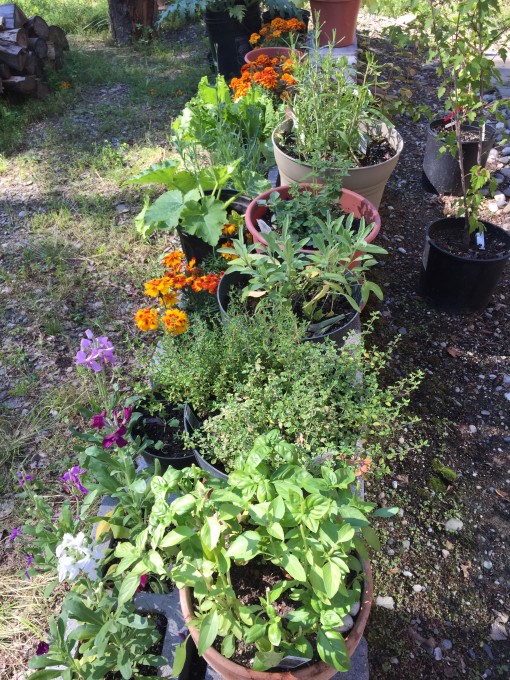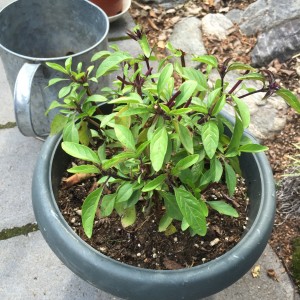I love growing herbs. They have so many great qualities to recommend them. They can be grown anywhere, even in a small space, such as a kitchen window. For the most part, they aren’t fussy, are easy to process and store, and only a few plants can supply you with wonderful flavor from your garden year round.
I like to plant them in pots on the porch. They are usually the very first harvest, as leaves can be used as soon as there are enough to spare. I pinch a few leaves of basil for fresh salad and think of the summer’s harvest to come. All summer long, almost every meal at home involves a trip to the garden to cut herbs. The smells and flavors of freshly harvested herbs are robust. Your hands smell of them, and the kitchen fills with bright aromas as you cut and crush them. The flavor of fresh herbs goes well with the summer bounty of zucchini, tomatoes, turnips, and greens. Later, the kitchen takes on a pleasant, medieval air, with bunches of drying herbs hung from the ceiling on hooks. Finally, the harvest of fresh herbs is over and winter rules over the space once occupied by the garden. Inside though, the aroma of garden herbs, added to moose stew simmering on the stove, fills the house with lingering smells of summer.

Most herbs considered perennial elsewhere are grown in Interior Alaska as annuals and many need to be started early indoors to ensure an adequate harvest. Some, like dill, fennel, or cilantro, can be grown by sowing seeds directly into the garden. A few, namely perennial garlic chives and Russian tarragon, I have managed to overwinter.
I have grown herbs from seed, but since I like a variety of herbs and only need a few plants of each, transplants are purchased from local nurseries. I grow parsley, oregano, thyme and lemon thyme; the latter a perfect addition to Alaska salmon (and very easy to grow). Basil, 3 or 4 kinds at least, such as sweet basil, Thai basil and lemon basil, are favorites. Almost always, there is marjoram, summer savory and French tarragon (for meat dishes and summer 3 bean salad). Sage, lemon balm and rosemary store well for winter and are featured in holiday meals. I always grow at least 1 or 2 varieties of mint, usually peppermint and spearmint, but sometimes pineapple mint or chocolate mint. All are wonderful for summer drinks and winter teas.
Herbs are well suited for container gardening. Adding more than one type of herb plant to a pot adds interest and beauty and also allows a variety of herbs to be grown in a small space. I find that I get a better harvest though, when I give each type of herb plant plenty of room in it’s own pot.
Some general rules for growing herbs:
- Most herbs mentioned prefer a slightly acidic to neutral soil. To fertilize, a small amount of compost as a side dressing or 1 or 2 applications of compost tea is usually enough, as they are generally not heavy feeders. The Denali Seed Company website suggests that if herbs are over fertilized they become leggy. If this happens, pinch them back to restore more compact growth. Most do well in sun to partial shade.
- Plant herbs as close to the kitchen as possible to have easy access for harvesting.
-

Thai basil plant with center and side stalks pinched back to encourage leaf growth from new side shoots. Periodically, pinch stems back to discourage flowering, and to encourage leaf growth. Once plants flower, foliage will become less tender as well. Encourage flowering if you are growing specifically to harvest seed. Dill, cilantro and mustard are some herbs commonly grown in Alaska and harvested for seed.
- Many common herbs, such as chives, cilantro, dill, mint, parsley, rosemary, sage and thyme all prefer cooler weather; and do well in Alaska’s cooler summers. Cilantro bolts easily in the sunlight of our long Interior days. Basil likes warmth so provide protection if your garden is in a cooler area.
- Water herbs if the soil is dry or if their leaves start to droop.
- Harvest through the season for immediate use, clipping stems from the top and side. The youngest leaves are usually the most tender; the older leaves the most flavorful. Clip chives at ground level and new shoots will grow. In the fall you can harvest the leaves and stems together.
Once harvested, herbs can be hung to dry, dried in a dehydrator, or frozen. They can also be prepared and saved as finished culinary products such as pesto or mustard. Woody herbs with small leaves, like rosemary, sage, or thyme, do fine when hung to dry. I use light cotton string to tie the stems together. Tender herbs such as basil, oregano, lemon balm, mint, onion and garlic leaves will usually retain their color and flavor better if dehydrated or frozen. You can use any commercial purchased dehydrator. You can also use a solar dryer, or dry them outside on a screen, though according to the National Center for Home Food Preservation (NCHFP) website, drying indoors or in a screen house is preferred to improve quality.
Herbs can also be dried in the oven. The NCHFP recommends temperatures between 95 and 125 degrees for drying herbs. Not all ovens can be used optimally to dry herbs, as some do not have temperature settings this low. The door should be propped open a little to allow moisture to escape. Once they are almost dry, you can leave the baking sheet or tray out for additional air-drying to remove any remaining moisture. It is really important that all the moisture is removed before putting them into the jars or they can get moldy, and even a small amount of moisture can change the flavor. I recycle spice or condiment jars for storing the dried herbs. It’s important to label them early in the process, as once dry, the plants and leaves are harder to identify. Store your dried herbs in a cool, dry place and then enjoy them all year long.

There are great references available in books and on the web on growing and using herbs. One of my favorite books is “The Complete Book of Herbs – A practical guide to growing and using herbs” by Lesley Bremmes. In addition to being a comprehensive reference with information on over 100 herbs, it makes a great coffee table book as it is filled cover to cover with high quality photographs of herbs.
Alaska Cooperative Extension Service publishes “An Alaskan Herb Garden” which is a 74 page guide on growing herbs in Alaska. This can be purchased for $15.00 and the publication # is FNH-002
Does anyone have any tips or suggestions on growing herbs in cool climates? Could anyone share their experience of growing herbs not mentioned in the article? Has any one tried growing Cilantro in a shade house or have any tips on keeping it from bolting? I would love to hear from fellow northern herbophiles.
Thank you so much for such great information! I find growing herbs and dealing with them other than as fresh harvest a bit intimidating and reading your post pointed out what I’ve been doing wrong all these years. I was able to grow Cilantro in between my cauliflower, and it didn’t bolt right away this year. I think the big leaves of the cauliflower helped keep the cilantro and soil cooler, because as soon as I harvested the cauliflower and took the shade away, the cilantro bolted.
What a great tip about the Cilantro. Definitely going to try it!
I am so glad I read this before I planted my cilantro! Thank you thank you and wish me luck! Will report back results (if good :D).
Which of these herbs that I have in pots now, will winter over outside if I plant them close to my house & cover with leaves:
Majoram, Oregano, Mint, Winter Savory, Lavender & Parsley. Will any of them do well in pots in my house? I live in Eagle River.
Thank you 🙂